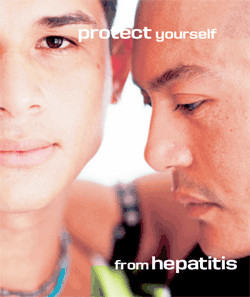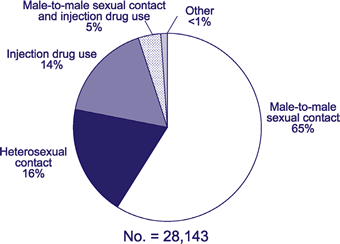Transmission categories of male adults and adolescents with HIV/AIDS diagnosed during 2004


STIs
Latino MSM are at especially high risk for sexually transmitted infections (also known as STIs), including chlamydia, syphilis, gonorrhea, and hepatitis. According to the Centers for Disease Control (CDC), up to 10% of all new hepatitis infections are MSM, especially MSM of color.
Latino MSM are put at higher risk for catching STIs due to a combination of cultural social factors that influence risky sexual behaviors. Among Latino MSM, anal sex is considered more satisfying than oral sex. Latino men are also less likely to use condoms with other men than they would with women, especially if the man in question is the assertive, or dominant, partner. The dominant partner is defined as the partner that inserts his penis into the other man. The use of illegal drugs, including amphetamines, has been connected with riskier sexual behaviors. Higher rates of child sexual abuse has been connected to higher rates of risky sexual behaviors as adults, especially for Latino MSM.
For migrant or immigrant Latinos, the so-called protective factors of Latino culture on MSM sexual behavior has yet to be fully evaluated. While some researchers claim that some traditional values have a protective influence on Latino MSM, others point to negative attitudes toward condom use and attitudes toward engaging in anal sex, especially among migrant MSM.
Migrant men who engage in male-to-male sexual activity (in part due both the lack of other available partners and without their social community to condemn their sexual behaviors) are also likely to infect sexual partners in their countries of origin, thereby spreading STIs.
For Latino MSM that self-identify as heterosexual, multiple studies have concluded that they tend to indulge in riskier sexual behavior and are least likely to seek help from either social services or health care professionals. They are less likely to use condoms and more likely to think that because they are not "gay," they are not at risk.
In general, all Latino MSM are less likely to approach their peer groups or local organizations about sexual health concerns, at least in part due to the effects of homophobia and the refusal to discuss what is considered deviant sexual behavior in the Latino community .
HIV/AIDS
Infection Statistics from California Collaborations in HIV Prevention Research
In California:
Through October of 2004, males who reported sexual contact with men represented 68% of cumulative AIDS cases and 72% of all males with HIV.
Of these, men of color represent 35% of AIDS cases and 41% of HIV cases.
For AIDS cases among men of color in 2002-2003, MSM (men who have sex with men) exposure was reported by roughly 60%.
Much of the research on the Latino MSM community has focused on behaviors around HIV/AIDS prevention, in large part due to the connection between HIV infection and male-male sexual contact. Through 2003, according to CDC statistics, MSM represented 48% of cumulative AIDS cases and 46% of the cumulative cases of HIV infection. The CDC said male-to-male sexual contact accounted for 62% or more of HIV/AIDS cases among Latino men. The same sexual behaviors that contribute to STI infection also contribute to infection with HIV/AIDS.
The Contributions of Racism, Poverty, and Homophobia
New studies and directions in the minority health field point to other contributions to risky sexual behaviors besides culture and sexual preferences.
Racism - Multiple studies have connected racism to risky sexual behaviors. In some studies, men who reported more risky sex had experienced more racism as adults and children. In sexual situations, especially interracial sexual situations, MSM of color (especially Latinos and African Americans) felt less able to negotiate condom use or safe sexual behavior with their partner, at least in part due to race.
Poverty - Several studies point to the pervasive effects of poverty on sexual behavior. Poverty and lack of sufficient resources can lead to situations where sexual safety is less important than survival. For sex workers, sex without a condom pays better than sex with one. For poor immigrants, not just money but fears of deportation may keep them from seeking help. In addition, some researchers believe poverty leads to hopelessness and therefore a greater risk of engaging in risky sexual behaviors.
Homophobia - In Latino culture, homosexual behavior is seriously stigmatized. Men who report greater levels of homophobia, both in their family and their society, report higher rates of risky sexual behavior. Notably, Latino MSM who have the support of their family report lower rates of sexual risk; therefore, familial support acts as a protective factor for Latino MSM.
For a discussion of cultural factors contributing to sexual risk, click here.